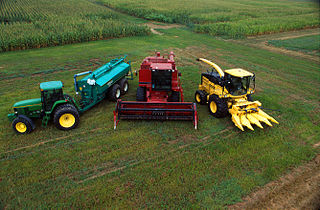The Department of Agriculture and Agri-Food, also referred to as Agriculture and Agri-Food Canada (AAFC), is the department of the government of Canada with responsibility for policies governing the production, processing, and marketing of all farm, food, and agri-based products. It is popularly called Ag-Canada.

Agribusiness is the business of agricultural production. The term was coined in 1957 by Goldberg and Davis. It includes agrichemicals, breeding, crop production, distribution, farm machinery, processing, and seed supply, as well as marketing and retail sales. All agents of the food and fiber value chain and those institutions that influence it are part of the agribusiness system.
Canada is one of the largest agricultural producers and exporters in the world. As with other developed nations, the proportion of the population and GDP devoted to agriculture fell dramatically over the 20th century but it remains an important element of the Canadian economy. A wide range of agriculture is practised in Canada, from sprawling wheat fields of the prairies to summer produce of the Okanagan valley. In the federal government, overview of Canadian agriculture is the responsibility of the Department of Agriculture and Agri-Food.

The 'Spartan' is an apple cultivar developed by Dr. R. C Palmer and introduced in 1936 from the Federal Agriculture Research Station in Summerland, British Columbia, now known as the Pacific Agri-Food Research Centre - Summerland. The 'Spartan' is notable for being the first new breed of apple produced from a formal scientific breeding program. The apple was supposed to be a cross between two North American cultivars, the 'McIntosh' and the 'Newtown Pippin', but recently, genetic analysis showed the 'Newtown Pippin' was not one of the parents and its identity remains a mystery. The 'Spartan' apple is considered a good all-purpose apple. The apple is of medium size and has a bright-red blush, but can have background patches of greens and yellows.
The Harovin Sundown pear is an attractive late-season fresh market pear with good storage capability. It is highly productive with no biennial bearing. The tree has excellent resistance to fire blight. This new cultivar, developed by Agriculture and Agri-Food Canada (AAFC) at its Research Centers in Harrow and Vineland Station, Ontario, Canada, is recommended by the Ontario Tender Fruit Producers' Marketing Board for general planting in Ontario. It is protected under Canadian Plant Breeders Rights legislation.

The Atlantic Food and Horticulture Research Centre is a branch of Agriculture and Agri-Food Canada's national network of 19 research centres stationed across Canada. The site is situated on 464 acres in Kentville, located in Nova Scotia's Annapolis Valley. The Centre's programs address agricultural challenges throughout the Canadian horticultural and food network, but primarily focus on the regional requirements of Atlantic Canada. On September 2, 2003, the centre's staff was recognized by Environment Canada for providing a volunteer climate observation station for a continuous 70 years. On January 26, 2011, and in honour of their centennial celebration, the centre was bestowed with an honorary membership to the Nova Scotia Fruit Growers Association in recognition of the centre's development and support of a sustainable tree fruit industry in Atlantic Canada.

'Creston' is an apple cultivar released by the Pacific Agri-Food Research Centre at Summerland, British Columbia.
Karen Beauchemin is a federal scientist in Canada who is recognized internationally for her research in ruminant nutrition. She is developing nutritional knowledge and technologies that help improve the efficiency of producing meat and milk, while reducing the environmental impacts of livestock production.
Elizabeth Pattey is a senior research scientist at Agriculture and Agri-Food Canada (AAFC) and the leader of the micrometeorology laboratory at the Ottawa Research and Development Centre. Her research supports nationwide improvement in the environmental performance of agriculture, in support of the United Nations' Framework Convention on Climate Change and Canada’s Clean Air Act. She is the co-author for over 80 peer-reviewed scientific publications, and her areas of expertise include trace gas flux measurement techniques, process-based models, and remote-sensing applications.
Yolande Dalpé is Research Scientist for Agriculture and Agri-Food Canada. Her research focuses on developing new information on taxonomy, phylogeny, distribution and biology of fungi, including systematic research related to biosecurity/alien invasive species as well as species involved in the development of bioproducts. She was awarded the Lawson Medal by the Canadian Botanical Association for her "cumulative, lifetime contributions to Canadian botany, for the research she has performed in mycology, and has been recognized nationally and internationally." The standard author abbreviation Dalpé is used to indicate this person as the author when citing a botanical name.
Michèle Marcotte, Ph.D., is a pioneer in food processing research. As a federal scientist with Agriculture and Agri-Food Canada (AAFC), she created a new method of fruit dehydration which can also be applied to vegetables, meat, or fish known as osmotic dehydration. Collaboration with private industry led to the design, development, installation, and start-up of a custom build dried-cranberry production line that is unique to the world. Her research was recognized with several awards including one from the Canadian Society for Bioengineering. Marcotte is currently the Director of the Ottawa Research and Development Centre located at the Central Experimental Farm in Canada.
Joyce Boye is a federal food research scientist with Agriculture and Agri-Food Canada with a specialty in value-added food processing, food safety and food quality. She has expertise on plant proteins and their importance in helping to improve human health and nutrition. The United Nations Food and Agriculture Organization appointed Joyce Boye Special Ambassador for North America for the 2016 International Year of Pulses.
Heather McNairn, is a federal research scientist at the Ottawa Research and Development Centre, Agriculture and Agri-Food Canada. She specializes in remote sensing technology, and her research focuses on the use of Synthetic Aperture Radar satellites (SARs) to monitor the condition of crops and soils.
The Harrington Research Centre is a government-run facility that is part of the AAFC umbrella of the agricultural sector. Located in Harrington, PEI, the centre has a vast wealth of resources all focused on the advancements of Canadian agriculture.
Tilak Raj Sharma is an Indian plant biologist, the executive director of the National Agri-Food Biotechnology Institute (NABI), and the chief executive officer of the Center of Innovative and Applied Bioprocessing (CIAB), both autonomous institutes under the Department of Biotechnology. Known for his studies in the fields of genomics and plant disease resistance, Sharma is an elected fellow of the National Academy of Sciences, India, the National Academy of Agricultural Sciences and the Indian National Science Academy. The Department of Biotechnology of the Government of India awarded him the National Bioscience Award for Career Development, one of the highest Indian science awards, for his contributions to biosciences in 2007.
The Pacific Agri-Food Research Centre is an agricultural research centre in British Columbia, Canada. The centre has been historically important in the development of tree fruits. It is administered by Agriculture and Agri-Food Canada and includes sites at Summerland and Agassiz.

Raymond L. Desjardins is a senior research scientist at Agriculture and Agri-Food Canada (AAFC) in the Agrienvironment Division of the Ottawa Research and Development Centre. His areas of expertise include agricultural meteorology, micrometeorology, air quality, and climate change. He is a Fellow of the Royal Society of Canada, was co-recipient of the Nobel Peace Prize awarded to the Intergovernmental Panel on Climate Change (IPPC) in 2007, and in 2018 was appointed as Member of the Order of Canada for his research in agrometeorology and for his innovative devices to quantify greenhouse gas (GHG) emissions.
Vernon Douglas Burrows is a research scientist emeritus at Agriculture and Agri-Food Canada (AAFC) and an international authority on oat breeding and utilization. He has bred and registered 28 varieties of oats, including AC Gehl, the “naked oat,” which is hulless and hairless and therefore easier to process and transport. In 2001 Burrows was appointed as Member of the Order of Canada, and in 2018 he was promoted to Officer of the Order of Canada for his research that has enhanced the production and nutritional value of oat-based foods.








